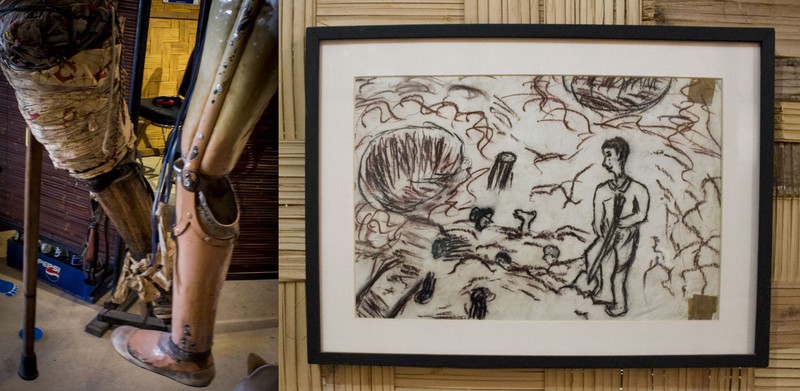

“We live in an age of anarchy,” proclaimed Richard Nixon in 1970, 11 years into America’s much-trumpeted battle with Vietnam–and six years into its strenuously denied “Secret War.” By 1975, the United States had littered the neutral sites of Laos and Cambodia with more explosives than the Allies rained down during World War II.
Of the 260 million cluster bombs dropped on Laos’s three million people, nearly a third failed to explode. Four decades later, most lay where they fell, claiming hundreds of lives and limbs each year in a country where the GDP per capita is just USD $1,660–a fraction of the cost of Western-made prostheses.
In the capital, Vientiane, the COPE center documents the grim consequences of this shortfall: housebound victims, crude wooden stumps for legs, DIY supports beaten from bomb casings. Foreign charities, meanwhile, often respond by donating secondhand prosthetic limbs–well-intentioned, but largely useless.
“It always has to be bespoke, because when you have an artificial limb, it’s not like shoes or off-the-shelf clothing, where you get a “‘left size 5 in blue,’ ” said Richard Hirons, the British expert behind gold-winning Paralympic sprinter Jonnie Peacock’s prosthetic leg.
“You talk to some charities that think secondhand is acceptable or somehow appropriate “¦ No matter where you are in the world, it’s the same rules. Making them last and affordable–that’s another thing. But cheap doesn’t need to mean poor quality,” he continued.
After years of honing, COPE is proving his point. Ruling out robotics and materials that price out farmers and are impossible to maintain, the organization has mastered the art of building bespoke, durable prostheses–for just $75 apiece. “I can help people to join society, to improve their daily living, and I am so happy for that,” said Kunthea Kim, COPE’s prosthetics and orthotics adviser, himself disabled since childhood.
COPE, he said, trains local engineers to make plaster casts of the amputation site and drape this with polypropylene, a cheap imported thermoplastic. The resulting prosthesis lasts around two years and is robust and waterproof enough to sustain the humid climate and jungle-and-rice-paddy-dominated terrain.

Kim, who trained for six years in Cambodia and Tanzania, cites poor education in Laos as a major barrier to ongoing development. But across the border, the technology has taken an unexpected leap.
Thanks to Chinese-Cambodian, Los Angeles-born brothers Ki How and Ki Chong Tran, Phnom Penh recently gained its first-ever 3D-printing facility. It’s a move the Trans, who run extensive design and business workshops for students, hope will boost entrepreneurship and innovation. High-functioning prosthetic components are already on the agenda.
“The prototype hand that we created [for open-source network e-Nable] was about 30 different pieces and you assemble it together,” enthused Ki How. “It’s kind of a pulley system, so you can actually close the fingers to help you grip water bottles, things like that.”
For the moment, he said, use is limited to prototyping small components like knee and ankle joints, printed in ABS or PLA. But this experimentation is only part of the potential; by facilitating rapid adjustments to CAD-designed prostheses, 3D printing could make prosthetic projects more sustainable.
“Usually it’s the fit of the prostheses that needs changing before any of the nuts and bolts wear out,” added Hirons. “[3D printing] can really speed that process up, because you just hit a button and make a small adjustment, and you’ve got a good fitting socket again.”
While printing parts in the United Kingdom remains prohibitively expensive, Cambodia’s low overheads could quickly establish the technology as a genuine contender. “The material itself is very cheap. The running is also cheap,” said Ki How, who estimates that a part requiring 15 hours’ machine time costs just $30″”$50 to produce. “That’s a lot better than, say, getting fitted for a traditional prosthetic, which can cost tens of thousands of dollars.”
Hirons added: “It does work. It can work.” But for now, he joked, “It’s probably sort of Playstation 1 stage!”


How We Get To Next was a magazine that explored the future of science, technology, and culture from 2014 to 2019. This article is part of our Vital Signs section, on the future of human health. Click the logo to read more.
